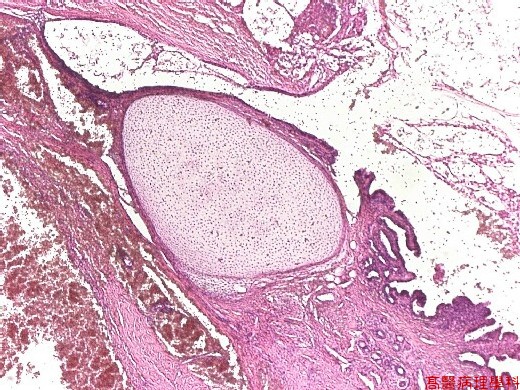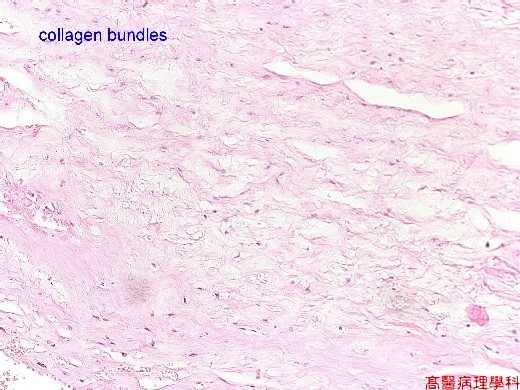ˇmSlide 72.ˇnCystic mature teratoma, Testis
A. Brief DescriptionsˇG
-
The tumor is composed of neural tissue,squamous epithelium and connective tissue stroma.
-
Devoid of EC cells.
B. Gross FindingsˇG
Cystic & multiloculated.
C. Micro FindingsˇG
-
All tissue are well differentiated or matured.
-
All types of tissue can be seen, the most common being nerve, cartilage, smooth muscle & various types of epithelium (alimentary, respiratory, squamous.
D. Others:
-
DefinitionˇGtrue neoplasm arising from totipotential cells & composed therefore of numerous types of tissue (more than one germinal layer).
-
Mature teratoma of testisˇGthe least aggressive of the nonseminomatous germ cell tumors of the testis.
E. ReferenceˇG
Robbins Pathologic Basis of Disease, 6th ed. P.1021-1022.
ˇ@
|
|
ˇi Fig. 72-1 (1X)ˇjAll types of tissue can be seen.
|
|
ˇi Fig. 72-2 (2X)ˇjLobulated and cystic lesion with cartilage seen in this view.
ˇ@
|
|
ˇi Fig. 72-3 (2X)ˇjChoroid plexus-like structure seen in this view.
ˇ@
|
|
ˇi Fig. 72-4 (4X)ˇjSkin elements and cartilage seen in this view.
ˇ@
|
|
ˇi Fig. 72-5 (10X)ˇjMature cartilage seen in this picture.
ˇ@
|
|
ˇi Fig. 72-6 (4X)ˇjSkin element with hair shafts seen.
ˇ@
|
|
ˇi Fig. 72-7 (4X)ˇjCiliated epithelium and glands seen in lefrt view.
ˇ@
|
|
ˇi Fig. 72-8 (4X)ˇjBrain tissue seen in this picture.
ˇ@
|
|
ˇi Fig. 72-9 (10X)ˇjEpithelial component seen.
ˇ@
|
|
ˇi Fig. 72-10 (10X)ˇjBrain tissue seen in this picture.
ˇ@
|
|
ˇi Fig. 72-11 (10X)ˇjCollagen seen in this view.
ˇ@
ˇ@
|
|
ˇi Fig. 72-12 (10X)ˇjBone and cartilage are seen.
ˇ@
|
|
ˇi Fig. 72-13 (10X)ˇjGastrointestinal mucosa seen in this view.












